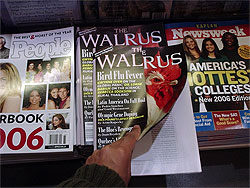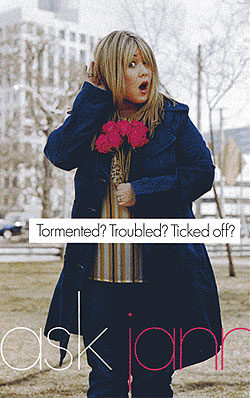Harper’s and Mother Jones have a lot in common with The Walrus. They’re idea-based magazines that have changed their business structures from non-profit organizations to foundations. They rely on charitable status for survival. Except, being Canadian-based, the Walrus had to jump over a few extra barriers to achieve its goal – barriers it may have created itself.
The laws governing eligibility for charitable status in the United States and Canada are similar, which is what convinced Ken Alexander, publisher and editorial director of the Walrus, that his magazine deserved charitable status. Although he has no objection to the distribution of the Walrus‘s American cousins in Canada, he says, “If they benefit from charitable status, we’re not giving Canada the same right. It’s not fair to Canadian magazines.”
The Walrus received notification of its charitable status in November 2005 – just in time, perhaps, as the magazine seemed to be on the verge of collapse. Alexander had been forced to pay expenses and freelancers out of his own pocket, spending his inheritance in the process.
A charity, according to the Canada Customs and Revenue Agency, like a magazine, has two basic advantages. First, the organization can issue official receipts for gifts received. “This reduces the individual donor’s income tax payable, and reduces the taxable income of a corporate donor,” the Canada Revenue Agency website states. Second, the organization itself does not have to pay income tax.
However, obtaining charitable status isn’t easy. “To qualify for registration,” says the Canada Revenue Agency website, “an organization must be established and operated for charitable purposes, and it must devote its resources to charitable activities. The charity must be resident in Canada, and cannot use its income to benefit its members.” Charitable purposes might include relief of poverty, improvement of education, advancement of religion or other uses that benefit the community.
Another domestic magazine that holds charitable status is Canadian Geographic. The Royal Canadian Geographical Society promotes education through its lecture series, geographic programs for children and grants for scientists. However, CG differs from the Walrus in many ways. First, it has obvious educational content, but, more importantly, it made certain that its foundation received charitable status before starting the magazine.
Magazine industry expert Lynn Cunningham says that it “seemed as if the Walrus hadn’t spent time investing the ease or difficulty of charitable status before it went ahead and created the magazine.” She thinks the founders would have been better prepared if they’d determined in advance whether or not the Chawkers Foundation – which had been created prior to the magazine’s October 2003 launch specifically to help finance the Walrus– counted as a charitable foundation.
Alexander’s father bankrolled the Chawkers Foundation. It had pledged to provide the magazine with $5 million-or $1 million annually for five years-with the hope that charitable foundation status was just around the corner. When the magazine later applied for charitable status to secure its long-term viability, it was denied.
Down but not out, Alexander set up the Walrus Foundation to try to show that the magazine deserved charitable status under the category, Support of Schools and Education. While he had little trouble getting a hearing in the press, convincing the government wasn’t so easy. After being rejected initially, Alexander knew due diligence was required. He had to prove that educational learning should not be restricted to classroom settings. The Walrus was allowing for an exchange of ideas and issues, he argued, rather than just people and things. “Ideas and issues that propel democracy need to be out there,” he says. “Education happens in many ways, and it shouldn’t be restricted to areas of specialization.”
Alexander wants the Walrus to play a role in bringing ideas being generated at universities to a larger audience. Otherwise, they will “remain in closed shop between research and records. Schools must have windows.” At an event in November, Alexander put it another way: “As the university is a kind of asylum for academics, keeping them off the streets and out of harm’s way, the Walrus is becoming the same thing for writers and artists.”
The Walrus generally reflects these educational values. Instead of doing the personality profiles that drive so many other magazines, it offers more general-interest material. The February 2006 issue, for example, contains an article with the sub-line, “How one Vancouver artist is breaking down cultural and consumer stereotypes,” and another story about a man wrongfully accused of murder and how it prompted him to consider becoming a regular on the police lecture circuit.
The charity director of Canada Revenue Agency, Colette Gentes-Hawn, says denying the Walrus charitable status wasn’t about being or not being fair. “They had to show they were meeting the requirements,” she says. “They didn’t have proof in the beginning. They were unclear as to how they were promoting arts and education beyond their publication.”
Magazine consultant D.B. Scott seems to agree. In The Globe and Mail he said, prior to the decision being made, that the Walrus barely met the education requirements for charitable status. If the Walrus Foundation achieved its desired status, he said, it would be the exception to the rule, rather “than any sweeping overhaul of the Canadian magazine regime.”
But Geist magazine editor Stephen Osborne disagrees. “There is no rule,” he says, “so there is nothing to be an exception to. All the Walrus case offers is a precedent.”
Of course, by now Alexander has breathed his sigh of relief. “We are transitioning from being a not-for-profit to a foundation,” he says. “There is a level of security for us.” In other words, the Walrus may now access the $5 million originally pledged by the Chawkers Foundation.
As part of its newfound status, the Walrus now holds public events to promote arts and education. The most recent one, “A Johnnie Walker Robbie Burns Day Celebration” – promising toasts, poetry and music in the spirit of Burns on January 25 – drew 150 journalists. Some who attended joked that the only information they really learned was about Johnny Walker Blue Label scotch. Writer Douglas Bell, who was also at the event, says he has to admit he didn’t learn a lot. “They didn’t discuss any issues,” he says. “It was more about light entertainment.”
The Walrus‘s first event, held November 24, 2005 at the Spoke Club in Toronto, featured a high-powered literary lineup. Noah Richler, Ann-Marie MacDonald, Wayne Johnston, Charles Foran and Lisa Moore were on a panel to discuss Richler’s 10-part CBC Ideas series, A Literary Atlas of Canada. The intent was to encourage a discussion of unifying themes in Canadian literature, among other things. The evening went well, according to people who were there. Richler’s series was to be reviewed by Foran in the December/January of the Walrus, which created a little perceptual dissonance. Foran, the reviewer, was on the same panel as Richler, the reviewee, which, on the surface at least, didn’t seem to leave a lot of room for critical distance.
Toronto Star book columnist Philip Marchand, who was invited to the event, wrote a column about the gathering three days later. In “Searching for a ’70s Rubber Soul,” he gently satirized the event (and himself). Mostly ignoring the panel’s thoughts on the country’s literary soul, Marchand cited the babble of Audi sponsors, the prattle about psychographics bringing like-minded people together and the burbling aesthetic judgment of Walrus creative director Antonio “Totally ’70s” De Luca.
But, as Bell says, events like “A Literary Atlas in Canada” and “A Johnnie Walker Robbie Burns Day Celebration” – as larded with marketing shills as they are – fulfill the magazine’s purpose in community building. They do indeed raise awareness of the Walrus and show appreciation for its writers and subscribers.
About the author
Shireen Khimani was the Columns Editor for the Spring 2006 issue of the Ryerson Review of Journalism.


